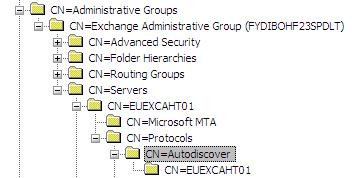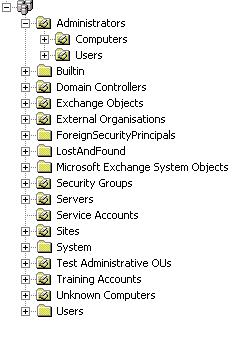AD Migration : Cleanup extensionAttributes
The Quest migration tools use extensionAttributes to keep objects in the source and destination domains. the script below will remove these entries. Change the desired extensionAttributes you wish to purge, as highlighted in red. You can also change the scope by changing strFilter and strOU.
Const ADS_PROPERTY_DELETE = 4
Const ADS_PROPERTY_UPDATE = 2
Const ADS_PROPERTY_CLEAR = 1
Dim strFilter ‘As String
Dim oConnection ‘As ADODB.Connection
Dim oRecordSet ‘As ADODB.RecordSet
Dim strQuery ‘As String
Dim strDomainNC ‘As String
Dim oRootDSE ‘As IADs
Dim vArray ‘As Variant()
Dim vSid ‘As Variant
Dim oDirObject ‘As Variant
Dim strOU ‘As String
‘ Find the domain naming context
set oRootDSE = GetObject(“LDAP://RootDSE”)
strDomainNC = oRootDSE.Get(“defaultNamingContext”)
set oRootDSE = Nothing
‘ Setup the ADO connection
Set oConnection = CreateObject(“ADODB.Connection”)
oConnection.Provider = “ADsDSOObject”
oConnection.Open “ADs Provider”
strOU = “OU=IT,”
strFilter = “(&(objectClass=user)(objectCategory=person))”
‘strFilter = “(&(objectClass=computer))”
‘strFilter = “(&(objectClass=group))”
strFilter = “(&(objectClass=contact))”
strQuery = “;” & strFilter & “;distinguishedName,objectClass,name,extensionAttribute8,extensionAttribute9,targetAddress”
‘Execute the query
set oRecordSet = oConnection.Execute(strQuery)
if oRecordSet.Eof then
WScript.Echo “No objects were found”
WScript.Quit(0)
Else
Dim vClasses ‘As Variant
Dim strClass ‘As String
WScript.Echo “The following objects were found:”
‘ Iterate through the objects that match the filter
While Not oRecordset.Eof
vClasses = oRecordset.Fields(“objectClass”).Value
strClass = vClasses(UBound(vClasses))
If IsNull(oRecordSet.Fields(“extensionAttribute8“).Value ) and IsNull(oRecordSet.Fields(“extensionAttribute9“).Value) Then
‘Values Empty
Else
WScript.Echo chr(34) & oRecordset.Fields(“distinguishedName”).Value & chr(34) & “,” & _
chr(34) & oRecordset.Fields(“name”).Value & chr(34) & “,” & _
chr(34) & oRecordset.Fields(“extensionAttribute8“).Value & chr(34) & “,” & _
chr(34) & oRecordset.Fields(“extensionAttribute9“).Value & chr(34)
If InStr(oRecordset.Fields(“name”).Value, “/”) Then
‘Ignore entries with a “/” in the canonical name – this will cause the script to fail
Else
set oDirObject = GetObject(“LDAP://” & oRecordset.Fields(“distinguishedName”).Value)
oDirObject.PutEx ADS_PROPERTY_CLEAR, “extensionAttribute8“, 0
oDirObject.SetInfo
oDirObject.PutEx ADS_PROPERTY_CLEAR, “extensionAttribute9“, 0
oDirObject.SetInfo
End If
End if
oRecordset.MoveNext
Wend
End if
‘Clean up
Set oRecordset = Nothing
Set oConnection = Nothing
Function OctetToHexStr(sOctet)
Dim k
OctetToHexStr = “”
For k = 1 To Lenb(sOctet)
OctetToHexStr = OctetToHexStr _
& Right(“0” & Hex(Ascb(Midb(sOctet, k, 1))), 2)
Next
End Function







